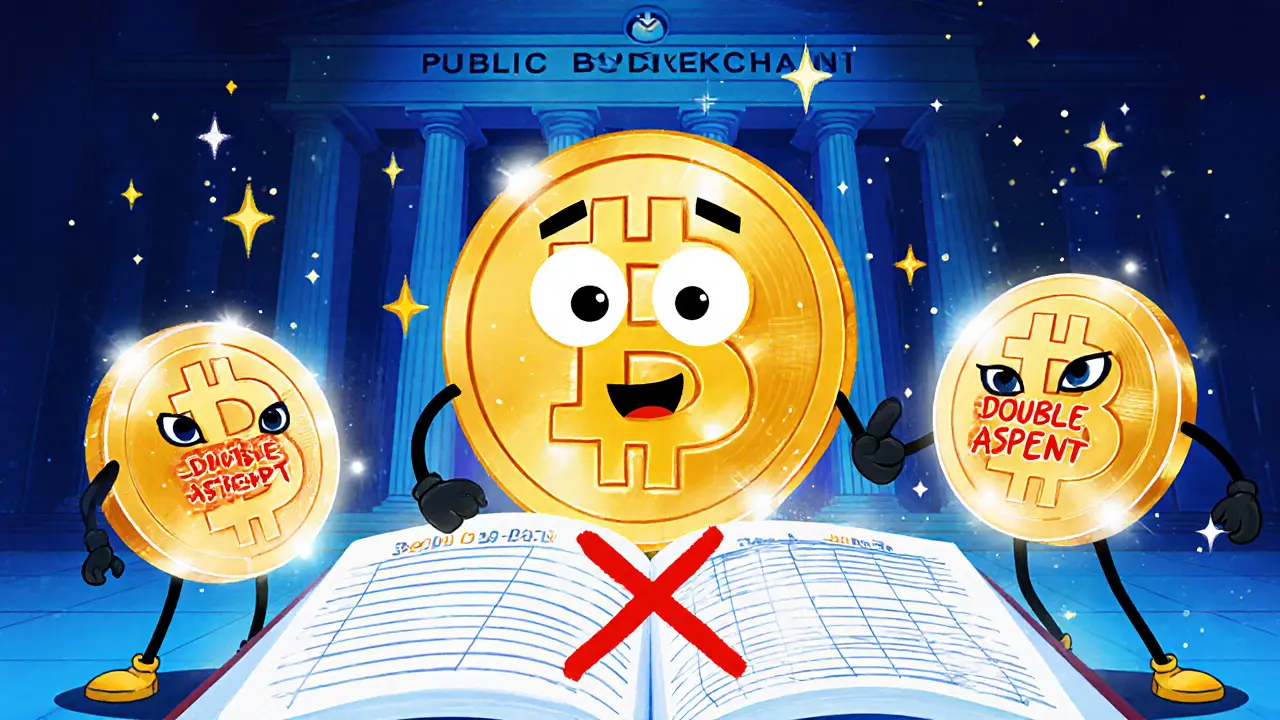
- 13 Mar 2025
- Elara Crowthorne
- 19
Bitcoin Double-Spending Prevention Simulator
Simulation Results
Click "Simulate Transaction" to see how Bitcoin prevents double-spending.
How Bitcoin Prevents Double-Spending:
- Uses UTXO model: Each transaction input must reference an unspent output
- Relies on Proof of Work consensus to validate transactions
- Requires block confirmations for finality
- Employs economic incentives to make attacks impractical
When you hear about Bitcoin a decentralized digital currency that operates without a central authority, the first question is often: how does it stop the same coin from being spent twice? The answer lies in a blend of cryptography, a public ledger, and economic incentives that together eliminate the Bitcoin double-spending problem.
What is Double-Spending?
Double-spending the act of trying to use the same digital token in multiple transactions is a classic vulnerability in any electronic cash system. If a user could copy a digital file representing a coin and paste it into two different payment messages, the scarcity that gives money its value would vanish.
Why Traditional Systems Need Trusted Intermediaries
Banking networks, credit‑card processors, and online wallets solve double-spending by keeping a central database of account balances. Every transaction is checked against that master ledger, and the institution guarantees that a balance can’t be overdrawn. This centralization creates a single point of failure-if the server is compromised or the operator goes rogue, the whole system is at risk.
Bitcoin’s Core Ingredients
Bitcoin removes the need for a trusted third party by combining three key components:
- Blockchain an immutable, chronological chain of blocks that records every transaction ever made
- Proof of Work a consensus algorithm where miners solve cryptographic puzzles to add new blocks
- Miners participants who devote computational power to secure the network and earn rewards

How the Blockchain Stops Double-Spending
Every transaction a transfer of bitcoins from one address to another, referencing specific previous outputs points to an earlier, unspent output (UTXO). When a transaction is broadcast, nodes check the UTXO set to ensure the inputs haven’t already been spent. If two conflicting transactions appear, the network uses the chronological order of blocks to decide which one is valid.
The block a bundle of transactions that is cryptographically linked to the previous block contains a hash of its predecessor. This hash chain makes it computationally infeasible to rewrite history without re‑mining every subsequent block.
Transaction Confirmation and Finality
After a transaction lands in a block, it receives its first confirmation an acknowledgement that the transaction is included in the blockchain. Each new block that follows adds another confirmation, raising the cost of reversing the transaction exponentially. The industry standard of six confirmations (roughly an hour for typical payments) makes the odds of a successful double‑spend astronomically low.
During the brief “unconfirmed” window, the transaction lives in the mempool a pool of pending transactions waiting to be added to a block. Nodes continuously scan the mempool for double‑spend attempts and will reject any transaction that tries to reuse already‑spent inputs.
Economic Security: Why 51% Attacks Are Impractical
The Proof of Work consumes massive computational resources, making attacks costly model ties network security to real‑world energy and hardware expenses. To double‑spend a confirmed transaction, an attacker would need to control more than half of the total hash rate-over 400 exahashes per second as of 2024. The electricity and hardware costs far exceed any potential profit from a successful double‑spend, creating an economic deterrent.

Traditional Payments vs. Bitcoin: A Quick Comparison
| Aspect | Traditional Digital Payments | Bitcoin |
|---|---|---|
| Authority | Centralized banks or payment processors | Decentralized network of nodes |
| Verification | Real‑time checks against a single ledger | Consensus via Proof of Work and UTXO validation |
| Finality | Can be reversed (chargebacks) | Immutable after six confirmations |
| Attack Cost | Depends on institutional security | Requires >50% of global hash rate |
| Transparency | Closed, proprietary databases | Public, auditable blockchain |
Advanced Features: Replace‑by‑Fee (RBF) and Mempool Management
Modern Bitcoin wallets can flag a transaction as replace‑by‑fee, allowing the sender to bump the fee if the original transaction is stuck in the mempool. While RBF can be abused for temporary double‑spends, miners still enforce the rule that only one version of a transaction with the same inputs can be confirmed. Merchants that require high security often wait for six confirmations or use RBF‑aware payment processors that monitor the mempool for replacement attempts.
Practical Takeaways for Users and Merchants
- Always verify that a transaction has at least one confirmation before considering it “paid.”
- For high‑value sales, wait for six confirmations to reach near‑absolute finality.
- Use reputable wallets that respect the UTXO set and provide clear mempool visibility.
- Understand that the security of Bitcoin’s double‑spending protection comes from both cryptography and economics.
- Stay aware of RBF‑enabled payments if you need instant settlement; adjust your risk tolerance accordingly.
Frequently Asked Questions
What exactly is double‑spending?
Double‑spending occurs when the same digital token is used in more than one transaction, effectively creating counterfeit money. In a purely digital world, copying data is trivial, so a robust system is needed to prevent this.
How does Bitcoin know which of two conflicting transactions is the real one?
Nodes check the order of blocks. The transaction that appears in the earliest valid block wins. Any later attempt to spend the same inputs will be rejected because the inputs are already marked as spent in the blockchain’s UTXO set.
What is a 51% attack and can it really happen?
A 51% attack means a single entity controls more than half of the network’s hashing power. With that majority, the attacker could rewrite recent blocks and attempt a double‑spend. In practice, the cost of acquiring >50% of Bitcoin’s hash rate (over 400 EH/s) makes the attack economically untenable.
Why do merchants wait for six confirmations?
Each new block adds roughly 10 minutes of security. After six blocks the probability of a successful reversal drops below 0.001%. This threshold balances speed and safety for most commercial transactions.
Can Replace‑by‑Fee be used to cheat the system?
RBF lets a sender increase the fee of an unconfirmed transaction, but only one version of that transaction can ever be confirmed. Miners will ignore any later attempt that tries to double‑spend the same inputs, preserving the integrity of the ledger.



19 Comments
Wow, reading this guide feels like watching a fireworks show of cryptographic brilliance!
Bitcoin’s UTXO model is the hero that steps in, shouting “no double‑spends here!” with flamboyant confidence. Every transaction gets its own spotlight, and the network’s proof‑of‑work drums up a rhythm that keeps sneaky thieves at bay. It’s like a grand orchestra where each block adds a booming note of security, echoing across the digital realm. The whole system dazzles with optimism, proving that trust can be built on math and community spirit.
Look, I get the hype about waiting six confirmations, but for most everyday purchases that’s overkill.
Why not settle for just a single confirmation and keep the commerce flowing? The network is so robust that a single block already slams the door on any double‑spend attempt. Sure, extra blocks add extra safety, but they also add extra patience – and nobody likes waiting forever.
The article glosses over the gritty reality of mining centralization.
It pretends the UTXO set is an immutable guardian, yet ignores how large pools can temporarily sway transaction ordering. This sanitized view masks the fact that “proof of work” isn’t a panacea; it’s a competitive race that can be gamed by well‑funded actors. Readers deserve a sharper lens.
Ah, the age‑old quest for certainty – as if confirming a transaction could ever elevate us to moral perfection.
We chase six blocks like monks seeking enlightenment, while the blockchain itself laughs at our futility. In the grand scheme, a double‑spend is merely a paradox, a reminder that certainty is an illusion we conveniently code away.
hey guys, i totally get why this can feel confusing at first.
just remember that once the tx shows up in a block, it’s basically locked down – like a sealed envelope. if you’re ever unsure, just check a block explorer and see the confirmations count. it’s super helpful and gives you peace of mind.
The UTXO model functions as a precise ledger of spendable outputs, ensuring that each input can be consumed only once.
When a miner includes a transaction in a block, the corresponding outputs are marked as spent, and subsequent attempts to reuse them are automatically rejected by every full node. This deterministic rule, combined with the cumulative difficulty of the proof‑of‑work chain, creates a mathematically provable barrier against double‑spending attacks. Consequently, the network achieves consensus without relying on any central authority.
Beyond the cryptographic guarantees, Bitcoin’s security rests upon economic incentives that align individual rationality with network integrity.
Miners invest substantial capital in hardware and electricity; attempting a double‑spend would jeopardize that investment by risking the forfeiture of block rewards. Thus, the protocol ingeniously channels self‑interest into collective trust, illustrating how game theory can underpin decentralized monetary systems.
For merchants, the practical takeaway is simple: verify at least one confirmation before delivering goods, and consider waiting for six confirmations on high‑value sales.
Most wallets now display confirmation counts prominently, and many payment processors offer automatic alerts when a transaction reaches the desired depth. Staying informed about these tools helps you strike the right balance between speed and security.
America built the backbone of this network, and we should be proud that our miners dominate the hash‑rate frontier!
Any attempt to double‑spend is just a feeble stunt by rivals who can’t match our sheer computational muscle. Let the world know: when you mess with Bitcoin, you’re messing with the biggest economic force the West has ever created.
While you’ve been cheering for the “power of US miners,” the real moral issue is the environmental toll of such massive energy consumption.
We cannot celebrate a system that burns fossil fuels like a reckless dragon. It’s time to question whether a technology that harms the planet is truly worth defending.
Security isn’t just a technical metric; it’s a covenant we owe to future generations.
If we let double‑spending slip through, we betray the trust that underpins every transaction, eroding confidence in the entire financial ecosystem. Let’s champion the rigorous confirmation standards that shield us from such betrayal.
In essence, the protocol’s layered defenses – from UTXO validation to proof‑of‑work difficulty and multiple confirmations – work together like a well‑trained team.
Understanding each piece helps newcomers appreciate why Bitcoin remains resilient, and it empowers them to make informed choices when transacting.
Bitcoin’s approach to preventing double‑spending is a masterclass in layered security design, beginning with the immutable definition of the UTXO set that guarantees each output can be consumed only once.
When a transaction is broadcast, nodes first verify that its inputs reference unspent outputs, rejecting any attempt to reuse a spent output outright.
This immediate validation at the mempool level filters out obvious double‑spend attempts before they reach miners.
Once a miner includes the transaction in a block, the block becomes part of the ever‑growing blockchain, and the spent outputs are permanently marked as used, making any later transaction referencing the same inputs invalid according to consensus rules.
The proof‑of‑work algorithm adds a further barrier by requiring miners to solve a computationally intensive puzzle, ensuring that adding a fraudulent block would demand an infeasible amount of hashing power.
Each additional block appended after the transaction deepens its confirmation count, exponentially decreasing the probability that an attacker could reorganize the chain to accommodate a conflicting transaction.
Statistically, after six confirmations the likelihood of a successful rewrite drops below one in a thousand, a threshold widely adopted by merchants for high‑value payments.
The economic incentives embedded in block rewards and transaction fees align miners’ profit motives with honest behavior, as attempting a double‑spend would risk forfeiting these rewards.
Moreover, the decentralized nature of the network means no single entity controls the ordering of transactions, reducing the risk of coordinated attacks.
In the rare scenario where a 51 % attack might be contemplated, the attacker would need to control the majority of global hash rate, an expense that dwarfs the potential profit from a double‑spend.
Consequently, the cost–benefit analysis heavily disfavors such malicious endeavors, reinforcing the system’s integrity.
The protocol also supports mechanisms like Replace‑by‑Fee, which, while allowing fee bumps, still respects the rule that only one version of a transaction with identical inputs can ever be confirmed.
This design prevents malicious actors from exploiting fee adjustments to execute temporary double‑spends, as any replacement transaction supersedes the previous one in the mempool but does not create additional spendable outputs.
Overall, the synergy of cryptographic validation, economic deterrence, and probabilistic finality creates a robust defense against double‑spending, illustrating why Bitcoin remains the gold standard for decentralized digital cash.
As the network continues to evolve, these foundational safeguards will remain pivotal in preserving trust among users.
yeah, i get the tech stuff, but let’s not forget that using this power responsibly matters more than any fancy math.
if we ignore the ethical side, we’re just building a playground for the reckless.
The way the guide breaks down each step is like a vivid tapestry, weaving together the gritty details of UTXO handling with the soaring concepts of network consensus.
It paints a picture where every confirmation is a brushstroke adding depth to the masterpiece of trust.
Some folks whisper that the 51 % threat is more than a theoretical nightmare – it’s a hidden agenda orchestrated by shadowy elites seeking to undermine decentralized finance.
They claim that powerful mining pools collude behind closed doors, ready to flip the ledger when it suits their interests.
While the sheer cost of such an operation is astronomical, the very notion fuels distrust among users who fear centralized control.
In truth, the open‑source nature of Bitcoin makes covert coordination exceedingly difficult, yet the specter remains a cautionary tale.
Understanding these narratives helps us stay vigilant, ensuring we don’t become complacent in the face of potential manipulation.
Ultimately, the robustness of the protocol lies in its transparency, which acts as a bulwark against conspiratorial machinations.
Just a heads‑up: keep an eye on your wallet’s confirmation count, and you’ll be fine.
Most people never run into trouble if they let the network do its job.
There’s chatter that big banks are waiting for a secret backdoor to slip into the blockchain, letting them roll back transactions at will.
When you think about it, the fact we still trust the system without a single central authority seems almost too good to be true.
Double‑spending? Not on Bitcoin.